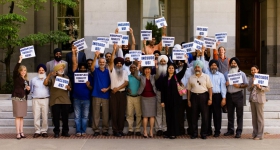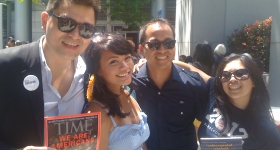photo by Wesley Oostvogels
More than half of new births in the United States are nonwhite. So suggests the latest wave of 2010 Census Data, summarized here by William Frey of the Brookings Institution:
“The new Census results show 49.8 percent of infants under age one are members of a race-ethnic minority -- up from 42.4 percent in 2000. Given this trajectory, and the fact that the Census was taken well over a year ago, it is almost certain we have now ‘tipped’ racially, and more than half of all national births are minorities.”
Unsurprisingly, these trends are driven mostly by demographic shifts in coastal and border states with large urban areas, like California, Texas, and Massachusetts. The interior of the United States continues to be predominately white, though this will likely soon change as well. And significant differences exist between groups -- Asian American babies, for example, continue to hover at between 4% and 5% of new birth cohorts, while multiracial and “Hispanic” births constitute most of the ongoing diversification of American cities.
These trends will of course raise obvious and necessary questions about how we describe the racial composition of the United States. But, as Frey points out, they’ll also create dilemmas about more than just how we talk about race; the most significant of these, in Frey's estimation, will stem from the “cultural generation gap” between the white majorities who came of age before 1965 and those who continue to come of age during an era of racial diversification and robust immigration and globalization
Now, I don’t so much mind that Frey (as surely many others will in the future) uses the metaphor of a “cultural gap” to describe the divergent experiences of whites, or that his usage of this metaphor strangely frames the rapid diversification of the US as a white-centric phenomenon. It’s important to explore how whites come to grips with their declining share (and claims to ownership) of the national population.
But it’s as, if not more, important to remember that metaphors are inherently distorting, even in the hands of the most careful authors. Different races don’t have different “cultures” that map neatly onto their boundaries, and it’s more than a little "Orientalist" to assume that Latinos, Asian Americans, blacks, and the panoply of multiracialities that increasingly “fill in the blanks” between these groups, all somehow possess tough “un-American” cultures that need to be chewed up and digested by the white majority. This assumption comes with an array of other, also implausible hypotheses: for example, that American culture is something stable and coherent that doesn’t change dramatically every generation, or that nonwhites aren’t part of the ongoing shaping of American culture.
So it’s important to scrutinize carefully the claim that the rapid “unwhitening” of the US will inevitably produce new "cultural" frictions. Americans, white and nonwhite alike, have been experiencing and adapting to the dislocations of time, generation, and culture for decades -- if not centuries. Now, as then, there are vociferous struggles over national culture, and what it means (and takes) to belong to America. But now, as then, there will also be opportunities to invent new identities, to create hybridized cultural practices and repertoires -- in other words, to collaborate in the everyday (re)fashioning of American life.










Comments